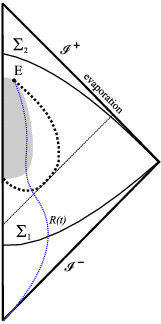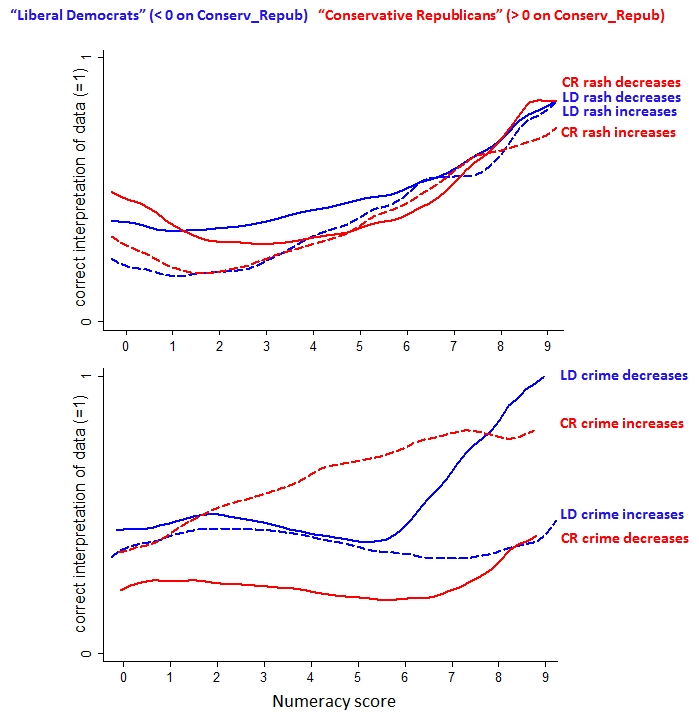People have been asking me about Stephen Hawking’s recent statement about black holes, under the mistaken impression that I know a lot about it. In case you missed it, here’s Nature’s take, and here’s Hawking’s actual preprint.
I think I know enough to say what the main idea is, although I certainly don’t know enough to evaluate the merits of Hawking’s proposal. I actually think that the whole business is more interesting for what it has to say about the process of communicating science anyway, so I’ll try to summarize the idea and then make some broader comments. If you skip ahead to the end, I won’t be terribly offended. I promise to say mean things about Hawking there, so don’t miss it.
There’s a fairly longstanding puzzle about what happens when you try to apply quantum mechanics to black holes. As Hawking argued long ago, quantum effects should cause black holes to emit radiation and gradually dwindle away. Later, people realized that this led to a problem. The predicted Hawking radiation was essentially random (thermal). As a result, almost all information about the material that went into forming the black hole was lost. You could form a black hole by throwing together all the books in the Library of Congress (along with a bunch of other stuff), and by the time it all radiated away there’d be no “memory” of any of that information.
This is a problem because there are broad principles in quantum physics that say that information is not lost. If you know the complete quantum state of a system at one time, you should be able to work out its complete quantum state (all the information it contains) at any other time, either earlier or later. The randomness of Hawking radiation is inconsistent with that. We don’t yet know the correct theory of quantum gravity, but if information is lost in black holes, it implies that that theory, whatever it might be, is inconsistent with what seem at the moment to be very fundamental principles.
In a more recent development, which I definitely don’t understand, some people have proposed that you can resolve this paradox by saying that there’s a “firewall” of intense radiation right at the horizon of any black hole.
What Hawking suggests in his recent preprint is that the paradox can be resolved by suggesting that black holes don’t actually have an event horizon but merely an apparent horizon. This raises some obvious questions: What the heck are these two types of horizon? Why does it matter what kind a black hole has? I’m not sure I know the answer to the second one, but I can tell you about the first one.
Let’s start with event horizons. By definition, an event horizon is the boundary of the causal past of future null infinity. That makes everything perfectly clear, right?
No? OK. Here’s a translation. If you’re inside of an event horizon, then neither you nor any signal you send out (traveling at speeds up to and including the speed of light) can escape and get out to arbitrarily great distances. If I’m outside the horizon, and you’re inside, then there’s no way you can get information to me.
An apparent horizon surrounds a region of space called a trapped region. In a trapped region, you can fire off a light signal directly away from the center, but it still moves toward the center. (I’m being slightly imprecise here, but not in a way that does any serious damage, I think.)
Those two concepts sound very similar, and indeed they are, but they’re not identical. The definition of an event horizon has to do with what happens to the signals you send out in the arbitrarily far future, whereas an apparent horizon is defined by what the signals do right away. You can in principle imagine a situation in which you send out light signals, and they all start heading in toward the center of the black hole, but later something changes and some of them manage to make it out. Then you’re inside an apparent horizon but not an event horizon. (There’s a theorem due to Hawking that says that this can’t happen under normal circumstances, but that theorem is based on classical physics, not quantum physics, so we can’t use it here.)
Here’s a diagram that may (or may not!) help.

This diagram, which I stole from an excellent blog post by an actual expert, shows an evaporating black hole. Here are the rules for interpreting it.
- Time increases as you go up.
- Signals that travel at the speed of light go at 45 degrees. Anything slower than that moves up the diagram along a steeper path.
- If you hit r = 0, you “reflect off” and go back the way you came.
- Distances are grossly distorted. In fact, the two diagonal lines labeled with those funny script-J characters are actually infinitely far away.
In this diagram, the diagonal line directly above the letters “R(t)” is the event horizon. Note that, if you’re above that line, in the little right-triangle region, any light signal you send out is guaranteed to hit the singularity, rather than making to the outside.
Here’s another diagram, stolen from an article by Hossenfelder and Smolin, illustrating another possibility.

This picture shows a what a black hole might look like without an event horizon. The shaded gray region is the area where weird quantum effects are important, so we don’t know what’s going on. The thick dotted line is an apparent horizon: if you’re inside there, then every light signal you send starts going in toward the horizon. (That’s not obvious from the picture, but take my word for it.) But there is no singularity, so those light signals eventually pass close to the center and then make it back out.
To phrase things in a way that will give fits to the actual experts (in the unlikely event that any have read this far), in this scenario light signals start to be pulled in toward the black hole, but the black hole evaporates out from under them before they hit a singularity, and so they subsequently make it out.
Hawking’s proposal is that black holes are like the second diagram, not the first one.
Now why does this matter? Well, I gather that the information-destroying property of black holes has to do with the existence of an actual event horizon. If light signals literally never make it out, then information is lost. If they just take a long time to get out, as in the case of an apparent horizon, then the information is in principle preserved, and there’s no problem. At least that’s what I understand Hawking to be saying, although whether he’s right or not I can’t say.
OK. On to some
Broader Remarks
First, neither Hawking nor anyone else is claiming that this makes any difference to what we see in practice. The actual black holes we see are so large that their evaporation is completely negligible. Our understanding of their behavior is unchanged by any of this. The question here is a sort of abstruse one: does the information that falls into a black hole disappear in a singularity, or does it “survive” until the end stages of black hole evaporation and then sneak out? This may make a big difference in our understanding of theoretical physics, but it doesn’t change the behavior of anything under “normal” circumstances.
Because of this, some people have complained bitterly about news reports breathlessly announcing things like “Hawking claims that black holes don’t exist.” It’s true that those headlines suggest something much more dramatic than Hawking’s actual claim, which is unfortunate. But in this instance I have to absolve the poor headline-writers of most of the blame. After all, here’s a direct quote from Hawking’s article:
The absence of event horizons mean that there are no black holes – in the sense of regimes from which light can’t escape to infinity. There are however apparent horizons which persist for a period of time. This suggests that black holes should be redefined as metastable bound states of the gravitational field.
If Hawking didn’t want people to jump to that conclusion, he shouldn’t have said this in this way.
But it seems to me that Hawking is guilty of something far worse. If you read the actual article, you’ll find no hint that anyone has suggested anything like this before. I’m not an expert in this field, but as far as I can tell this is decidedly not the case. For instance, the Hossenfelder-Smolin paper that I stole that diagram from lays out this possibility quite clearly and cites a number of previous works that apparently discuss similar ideas. None of these works are mentioned.
I’d be interested to know what actual researchers in this field think, but I find it hard to see any way to escape the conclusion that this is an appalling failure to uphold basic academic standards.
(Note: Hawking’s article is a summary of a talk he gave and is not apparently submitted for publication in a journal. I don’t think that provides any sort of excuse, but maybe others do.)






